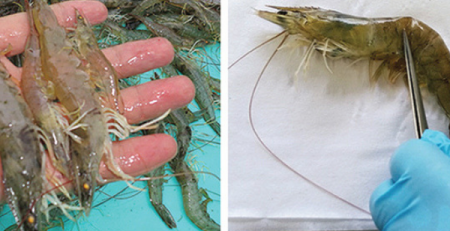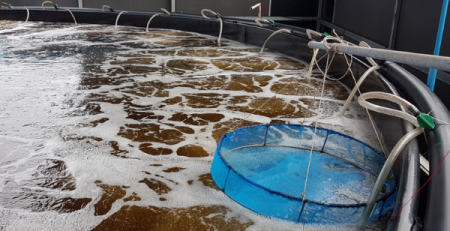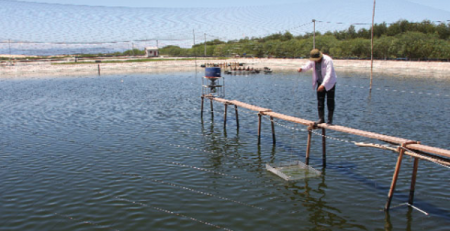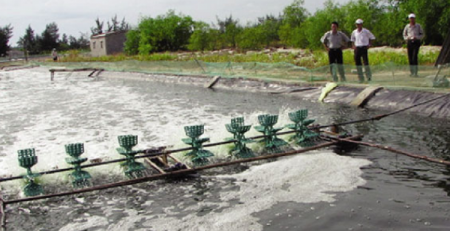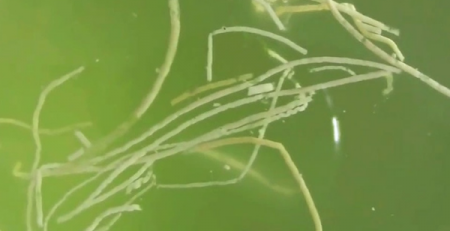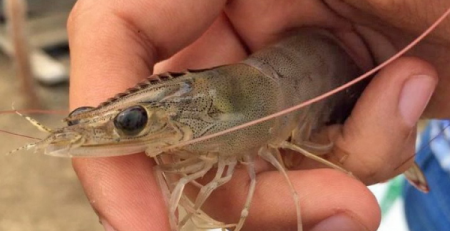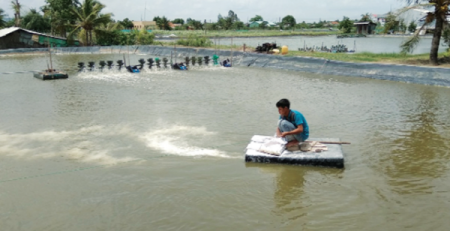Note for the new crop
Nội dung bài viết
Farmers need to perform well in preparation when entering the new crop, in order to achieve high efficiency and productivity.

Sanitation and disinfection of tarpaulin before each crop
Designing ponds and ponds
Shrimp farming needs sedimentation ponds covering an area of about 20-30% and waste water treatment ponds occupy about 10% of the pond area. Ponds should be convenient for water supply and drainage, the location of ponds must have electricity and roads to facilitate the transportation of breeds, feeds and shrimp products. Ponds should have an area of about 2,000 – 4,000 m2, rectangle, 1.5 – 2 times longer than the width to facilitate care.
In the new crop, the pond water needs to be drained, using lime (CaO) spread evenly to the bottom, the dose is 10-12 kg / 100 m2, the pond has a background of acid sulphate (low pH) need to increase the amount of lime applied 1 times , 3 – 1.5 times higher than normal, plowing the pond bottom for lime to mix with the soil. Take water into the pond (20 – 30 cm deep), wash 2-3 times, dry dry, spread agricultural lime (CaCO3), then continue to dry the pond for 5-7 days. For tarpaulin, use Chlorine 20 – 30 ppm to spray on the disinfected surface, dry 1-2 days for the chlorine to evaporate, then take water to the pond.
Shrimp seed
This is an important step to decide the success of up to 60%, the shrimp must be healthy, uniform in size, not distributed, bought from reputable farms and companies. Before buying shrimps, make sure that the shrimp seed has been quarantined, not incubated, and can check the health of shrimp by the Formol shock method. Salinity and pH of the seed and nursery production should be checked for proper adjustment.
Choose food
Food accounts for more than 50% of the total cost of the crop, so it is necessary to select food agents representing big and reputable producers. Farmers should base on each stage of shrimp development and choose the type of feed to ensure 2 criteria that provide sufficient nutritional content and medium size of shrimp. Should have storage to store food, when taking food should not take much, avoid long-term mold, rancid causing disease for shrimp.
Chemical treatment
Based on the technical process of shrimp farming to proactively list the list of drugs and environmental treatment chemicals when improving ponds and raising process. Farmers can contact reputable supply agents to get quality medicines, chemicals and probiotics. In the process of using drugs, chemicals and biological products, it is necessary to carefully consider the features and effects of products to have a rational use method, in addition to consult and exchange information with other products. Experienced farming households in the region or technical experts to choose and use the most effective method.
In order to know the level of the quality of the pond water, whether it is polluted or not, farmers should buy some water environment testing tools such as measuring or testing machines: Oxygen, NH3, NO2, H2S, pH and alkalinity, follow the instructions on the packaging.
Fan
Fans have the effect of providing dissolved oxygen for farmed shrimp, creating waste collection flow into the middle of the pond, in addition to air fans also provide dissolved oxygen for the beneficial bacteria at the bottom of the pond to decompose organic matter.
Currently, there are 2 types of plastic fan blades and porcupine fans. Farmers need to predict farmed shrimp production to calculate reasonable fan layout. Ponds with white shrimp with high density can use porcupine to fan oxygen to the bottom of the pond, the number of fans is only two thirds of that of the wing fan. Households should have backup generators in case of power outages.
Pond improvement
Before renovating the pond for 20 days, it is necessary to rehabilitate the settling pond and treat the water in the settling pond first. Ponds must be dredged with mud and tarpaulin (if financially available). Ponds must be compacted carefully to avoid water leakage, pond depth (including the shore) must be over 1.5 m. For earthen ponds, liming is required to stabilize the pond bottom environment, depending on the pH index of the bottom substrate, increasing the amount of lime applied accordingly.
Notebook
It is necessary to prepare a record book for buying and selling shrimp farming diary. The book of buying and selling is useful to help farming households account for the amount of investment, total revenue of the crop, then calculate the economic efficiency after 1 shrimp crop.
Source: Vietnam Fisheries Magazine


